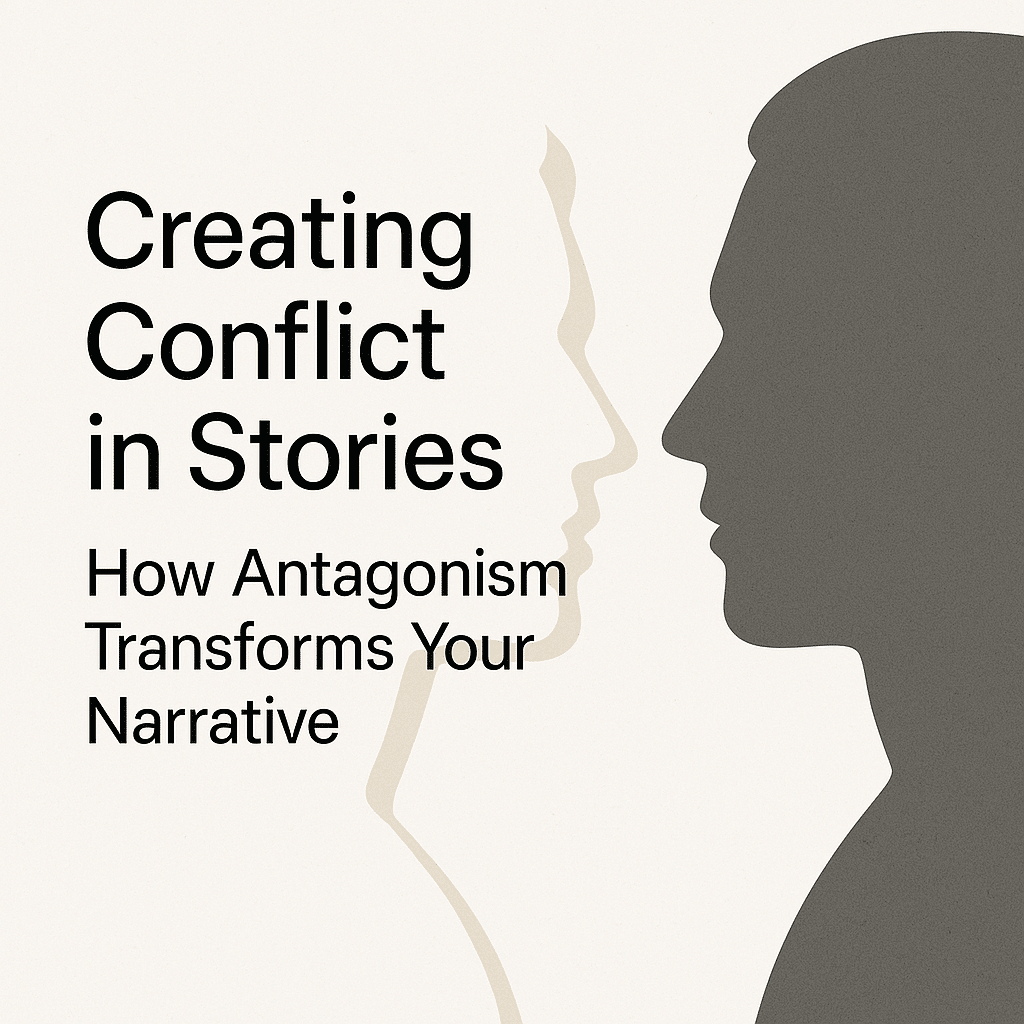👉 Write a book you're proud to publish 👈
Ever wonder why some stories keep you turning pages late into the night, while others leave you flat despite beautiful prose and intriguing characters? The answer often comes down to one crucial storytelling element: antagonism.
In this post, we’ll dive into the concept of antagonism, why it matters, and how you can use it to start creating conflict in stories that truly captivate readers.

What is Antagonism (Really)?
At its core, antagonism is any force that opposes your protagonist’s goal. It’s not just about villains twirling their mustaches. Antagonism is broader and more nuanced than that.
Sources of Antagonism
Antagonistic forces can take many shapes:
- Characters – Villains, sure, but also allies, mentors, and love interests
- Nature – Think storms, wilderness, disease
- Society – Rules, expectations, prejudices
- Objects – A locked door, a ticking clock, a lost phone
In The Wizard of Oz, the tornado is an antagonistic force. In Pride and Prejudice, societal expectations block Elizabeth Bennet. Even Trinity and Morpheus in The Matrix act as early antagonists to Neo—challenging him, disrupting his beliefs, and driving the story forward.
The Essential Elements of Antagonism
Effective antagonism fuels your story with a battle for control:
- The antagonist applies pressure
- The protagonist pushes back with resistance
- The clash creates high-stakes tension
This struggle is the lifeblood of compelling storytelling. Without it, there’s no urgency, no suspense, and no reason for your reader to stay invested.
How Effective Antagonism Works
Creating conflict in stories means ensuring your antagonist isn’t just an obstacle, but a persistent and meaningful force.
Three Key Functions of Antagonists
- Seek control – Use manipulation or coercion to gain power over the protagonist
- Break resistance – Try to overwhelm and force submission
- Push relentlessly – Keep applying pressure until a turning point arrives
In The Hound of the Baskervilles, constant threats challenge Sherlock Holmes. This relentless pressure forces him to think, adapt, and act—keeping readers glued to the page.
The Battle for Control
This battle is what turns a scene from passive to powerful. The protagonist resists to:
- Maintain autonomy
- Protect what matters
- Escape or outwit domination
Meanwhile, the antagonist fights to:
- Control the outcome
- Win at any cost
- Undermine the protagonist’s will
This back-and-forth fuels the question at the heart of every story: Who will get what they want?
Antagonism at Different Levels
Many writers focus on the big bad villain but forget that creating conflict in stories means using antagonism at multiple layers.
Story-Level Antagonism
This is your overarching conflict:
- Star Wars – The Empire vs. Luke Skywalker
- The Lord of the Rings – Sauron vs. Middle-earth
- Pride and Prejudice – Social norms vs. personal happiness
Scene-Level Antagonism
Every scene needs tension. Ask yourself: What’s blocking your protagonist right now?
Examples:
- A storm delaying a mission
- A best friend disagreeing at the worst time
- A locked door, a flat tire, a secret revealed
If a character gets what they want too easily, the scene falls flat. Add resistance.
The Connection Between Levels
The best stories link scene-level and story-level antagonism.
In The Hunger Games:
- Story-level: The Capitol’s control
- Scene-level: Tracker jackers, betrayals, internal fear
Each moment ties back to the bigger conflict, deepening the reader’s investment.
Practical Applications: Creating Stronger Antagonism
Here’s how to start creating conflict in stories that keeps readers hooked.
Match Genre Expectations
Every genre treats antagonism differently:
- Thrillers – Escalating danger
- Romance – Obstacles to love
- Fantasy – External and internal threats
- Mystery – Deception and misdirection
Understand your genre, then raise the stakes.
Create Meaningful Stakes
Without real stakes, antagonism is just annoying. Great stories layer three types of stakes:
- External: What physically happens (defeat the dragon, solve the crime)
- Internal: What happens to the character (prove their worth, heal their heart)
- Philosophical: What the outcome means (justice, redemption, freedom)
The Test of Strong Antagonism
Ask yourself:
- Can the protagonist easily avoid this obstacle?
- Does the outcome matter deeply to both sides?
- Does the antagonist persist?
- Is the conflict aligned with the story’s theme?
Answer “yes” to most of these, and you’re in solid territory.
Antagonism: The Engine of Storytelling
Without antagonism, you don’t have a story—you have a sequence of events. The friction between what your protagonist wants and what stands in their way creates momentum.
Examine Your Story
Run a quick diagnostic:
- Is there resistance in every scene?
- Is the opposition clear and personal?
- Do the stakes matter?
- Does the pressure intensify?
If not, you’ve found your next revision target.
The Protagonist Shines Against Pressure
Here’s the paradox: The stronger the antagonism, the more heroic your protagonist appears.
Watching them struggle and grow through opposition earns readers’ respect and admiration, not just sympathy.
Conflict Beyond the Villain
Remember, antagonism can arise from many sources:
- Complications – A plan falls apart
- Competing priorities – Tough choices must be made
- Misunderstandings – Good people clash
- Internal struggle – Doubt, fear, trauma
Layering these keeps your narrative rich and unpredictable.
Final Thoughts on Creating Conflict in Stories
If you want readers to care, create meaningful resistance. Let antagonistic forces test your characters. Let the stakes rise. Let the pressure build.
It’s this tension—this engine of antagonism—that transforms a story from forgettable to unforgettable.
So next time you’re stuck, ask: What’s making this hard for my protagonist? The answer is often the key to everything.